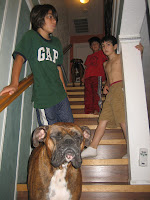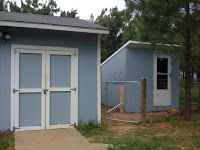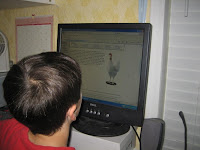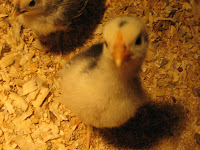Yesterday, news reports of possible twister activities filled the local TV and radio stations. I took few minutes to prep the area where we and our grandsons would take cover should the need arise; then we rehearsed so they would know what to do if a "take cover" warning was issued.
 "Tornado season" is generally in the spring with May and June being the peak months. Although I've lived in Arkansas for over 30 years, I've rarely seen tornado action--until last year! 2008 brought on more tornado activity in one season than I had seen in all my years in AR combined! The news revealed devastation just miles away as tornadoes hit parts of Arkansas relentlessly for months.
"Tornado season" is generally in the spring with May and June being the peak months. Although I've lived in Arkansas for over 30 years, I've rarely seen tornado action--until last year! 2008 brought on more tornado activity in one season than I had seen in all my years in AR combined! The news revealed devastation just miles away as tornadoes hit parts of Arkansas relentlessly for months.Everyone should know what to do if looking into the ugly face of a twister. Unlike storm chasers who caught amazing footage in last year's barrage of tornadoes in AR (Gilmore, AR, Northeast AR) I prefer to hunker down, take cover, and not chase monsters!
My grandsons spend every other weekend with us (the weeks that Cassie has chemo), so I wanted to ensure they knew exactly what to do if a warning was issued by the National Weather Service. We started by giving the tornado drill a two-word code called "Take Cover." At the "code words" the boys rehearsed exactly what to do. They practiced not "wasting time" or "asking questions" or "arguing" or "knocking each other over," but rather moving calmly but quickly toward the shelter. We even taught the dogs what to do if we say, "take cover."

Down the stairs they went from the upstairs den where they were hanging out toward the interior closet in the lower floor. They know to always move to the lowest level of a house.
Because most homes do not have basements here in NWA, an interior room or closet is the next best place to "take cover."

Boston led his younger brothers through the lower floor to the shelter.
The dogs naturally followed their "buddies" to the shelter. (Dogs and boys travel as a "pack" regularly anyway!)

Around the corner, past the kitchen and down the interior hall, the entourage marched in line to their assigned posts.
(They had fun "posing" for the pictures of their drill.)
 Caden & Riley took their place in the closet under the stairs.
Caden & Riley took their place in the closet under the stairs.Because we knew earlier that the weather was threatening, we placed "sitting" and "head covering" pillows to await us in the closet if needed.
The dogs reluctantly took their place in a nook in this interior hall.
 Boston took his place in the pantry closet right across from his brothers--just 4 feet away-- which left a place for Dennis and me in between them all.
Boston took his place in the pantry closet right across from his brothers--just 4 feet away-- which left a place for Dennis and me in between them all.During rehearsal, Boston ensured that there were pillows waiting for me and Papa as well. (So sweet!)





The closet always has flashlights, an emergency radio, bottled water, a first aid kit, and some "emergency snacks."
Even though I'm convinced that the chances of a tornado actually hitting our house is slim to none, I would never ignore or take any warning lightly. However, for entertainment and distraction during a "take cover" tornado warning, I keep healthy finger foods in the closet. I mean, why freak out when you can snack on nuts and dry fruit?
So now, we're prepared. Next time I say "take cover," the boys (and the dogs) know exactly what to do, where to go, and how to stay as safe as possible in the midst of a tornado.
Click here to learn about "myths" when taking cover.

Tornado Facts
- A tornado may be in close proximity to sunshine, or totally enshrouded in heavy rain.
- Sometimes the air before a twister has an eerie calm; sometimes strong, gusty winds are followed by a tornado.
- Large hail and tornadoes can be produced by the same thunderstorm although many times hailstorms are not accompanied by tornadoes.
- Often, tornadoes move from the SW direction, but they can travel from other directions too.
- Twisters can be many sizes or shapes: Wizard-of-Oz-like funnel, snake-like "multiple vortex" funnels, long rope-like shapes or wide, churning, "smoky"looking tornadoes
- It is said that a tornado sounds like a freight train or jet engine, but you may not hear these sounds until it is too late.
I'm sure Dorothy and Auntie Em would be proud of us for taking precautions against violent weather!































